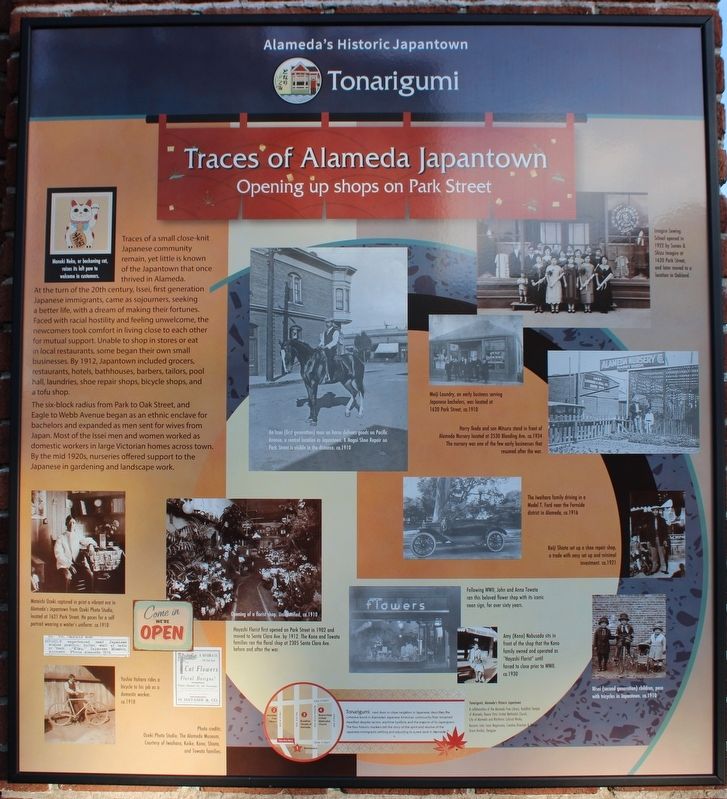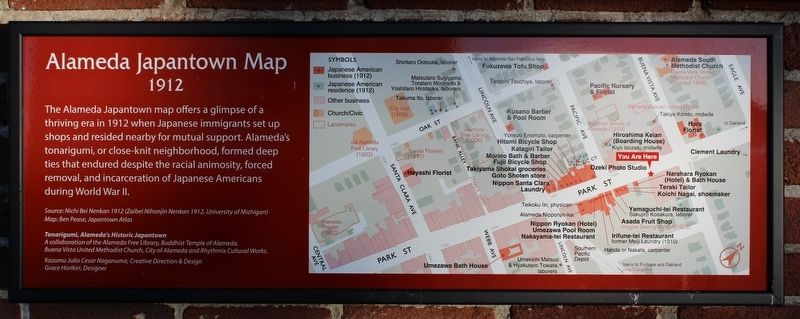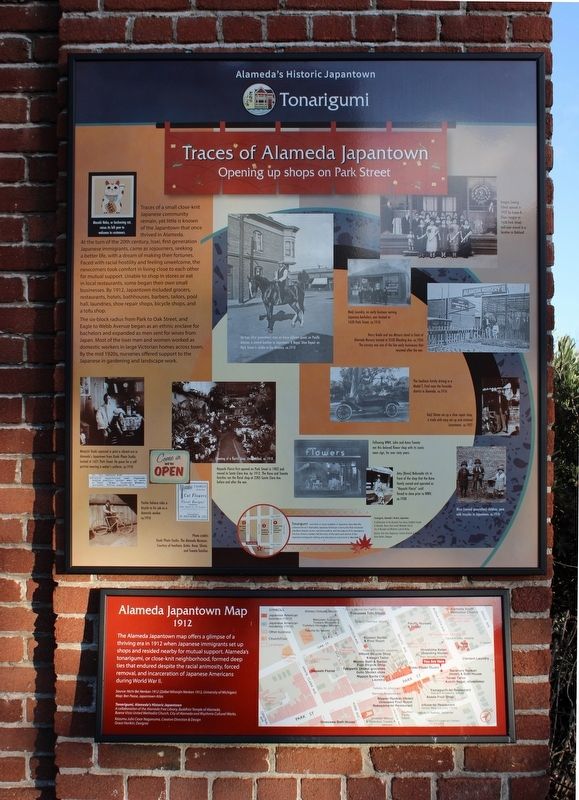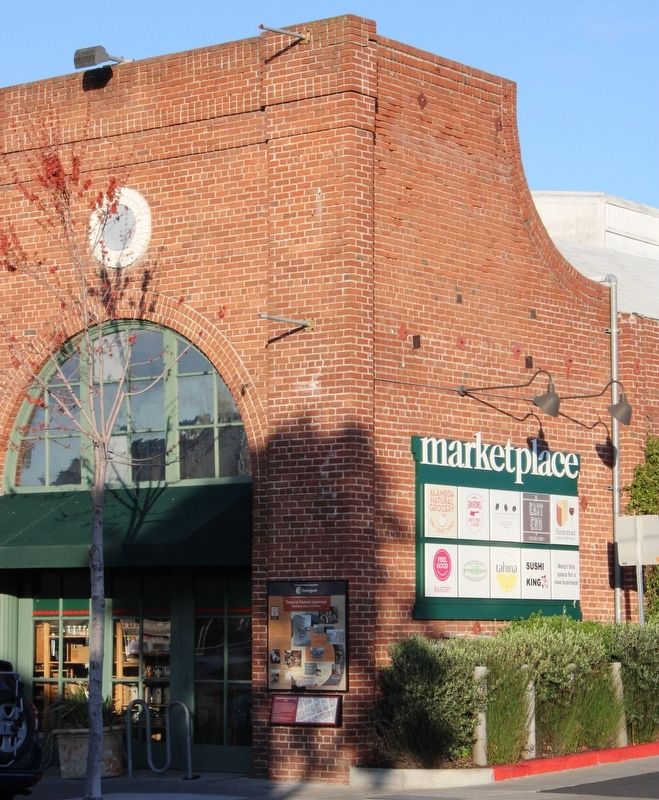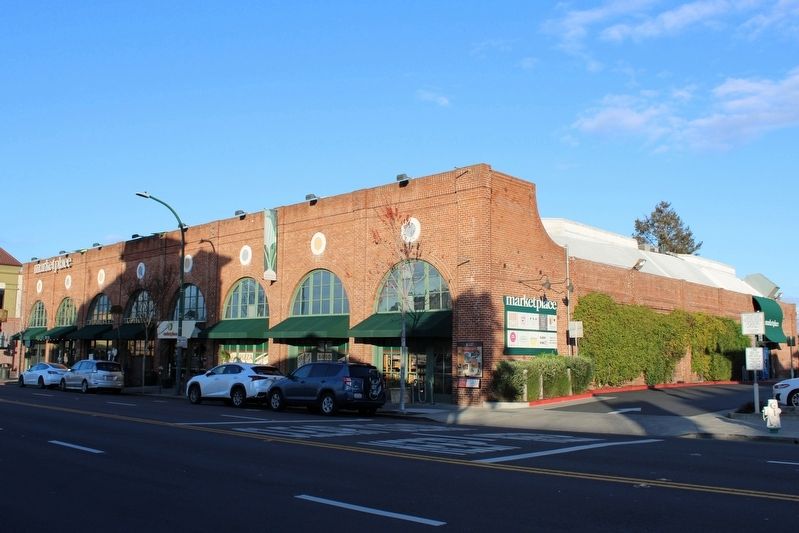Alameda in Alameda County, California — The American West (Pacific Coastal)
Tonarigumi
Alameda’s Historic Japantown
Opening up shops on Park Street
Traces of a small close-knit Japanese community remain, yet little is known of the Japantown that once thrived in Alameda. At the turn of the 20th century, Issei, first generation Japanese immigrants, came as sojourners, seeking a better life, with a dream of making their fortunes. Faced with racial hostility and feeling unwelcome, the newcomers took comfort in living close to each other for mutual support. Unable to shop in stores or eat in local restaurants, some began their own small businesses. By 1912, Japantown included grocers, restaurants, hotels, bathhouses, barbers, tailors, pool hall, laundries, shoe repair shops, bicycle shops, and a tofu shop.
The six-block radius from Park to Oak Street, and Eagle to Webb Avenue began as an ethnic enclave for bachelors and expanded as men sent for wives from Japan. Most of the Issei men and women worked as domestic workers in large Victorian homes across town. By the mid 1920s, nurseries offered support to the Japanese in gardening and landscape work.
Inset Images:
Maneki Neko or beckoning cat, raises its left paw to welcome in customers.
An Issei (first generation) man on horse delivers goods on Pacific Avenue, a central location in Japantown. K Nagai Shoe Repair on Park Street is visible in the distance. ca. 1910
Imagire Sewing School opened in 1922 by Sunoo & Shizu Imagire at 1620 Park Street, and later moved to a location in Oakland.
Meiji Laundry, an early business serving Japanese bachelors, was located at 1620 Park Street, ca. 1910
Harry Ikeda and son Mitsuru stand in front of Alameda Nursery located at 2530 Blanding Ave. ca. 1934. The Nursery was one of the few early businesses that resumed after the war.
The Iwaihara family driving in a Model T. Ford near the Fernside district in Alameda, ca. 1916
Keiji Shiota set up a shoe repair shop, a trade with easy set up and minimal investment. ca. 1921
Mataichi Ozeki captured in print a vibrant era in Alameda’s Japantown from Ozeki Photo Studio, located at 1621 Park Street. He poses for a self portrait wearing a waiter’s uniform. ca. 1910
Yoshio Itahara rides a bicycle to his job as a domestic worker. ca. 1910
Photo credits: Ozeki Photo Studio, The Alameda Museum, Courtesy of Iwaihara, Koike, Kono, Shiota, and Towata families.
Hayashi Florist first opened on Park Street in 1902 and moved to Santa Clara Avenue. By 1912. The Kono and Towata families ran the floral shop at 2305 Santa Clara Ave. before and after the war.
Amy (Kono) Nobusada sits in front of the shop that the Kono family owned and operated as “Hayashi Florist” until forced to close prior to WWII. ca. 1930
Nisei (second generation) children, pose with tricycles in Japantown. ca. 1910
Tonarigumi, next door or close neighbor in Japanese, describes the cohesive bond in Alameda’s Japanese American community that remained steadfast despite racism, wartime hysteria, and the erasure of its Japantown. The four historic markers tell the story of the spirit and resolve of the Japanese immigrants settling and adjusting to a new land in Alameda.
Tonarigumi, Alameda’s Historic Japantown
A collaboration of the Alameda Free Library, Buddhist Temple of Alameda, Buena Vista United Methodist Church, City of Alameda and Rhythmix Cultural Works.
Kazumu Julia Cesor Naganuma, Creative Direction & Design
Grace Horikiri, Designer
Lower Map Panel:
1912
The Alameda Japantown map offers a glimpse of a thriving era in 1912 when Japanese immigrants set up shops and resided nearby for mutual support. Alameda’s tonarigumi, or close-knit neighborhood, formed deep ties that endured despite the racial animosity, forced removal, and incarceration of Japanese Americans during World War II.
Source: Nichi Bei Nenkan 1912 (Zaibei Nihonjin Nankan 1912, University of Michigan)
Map: Ben Pease, Japantown Atlas
Tonarigumi, Alameda’s Historic Japantown
A collaboration of the Alameda Free Library, Buddhist Temple of Alameda, Buena Vista United Methodist Church, City of Alameda and Rhythmix Cultural Works.
Kazumu Julia Cesor Naganuma, Creative Direction & Design
Grace Horikiri, Designer
Erected by City of Alameda.
Topics. This historical marker is listed in these topic lists: Asian Americans • Immigration • Industry & Commerce • Settlements & Settlers. A significant historical year for this entry is 1912.
Location. 37° 46.061′ N, 122° 14.387′ W. Marker is in Alameda, California, in Alameda County. Marker is on Park Street east of Pacific Avenue, on the right when traveling east. The resin marker is mounted to the southwest corner of the red brick building. Touch for map. Marker is at or near this postal address: 1650 Park Street, Alameda CA 94501, United States of America. Touch for directions.
Other nearby markers. At least 8 other markers are within walking distance of this marker. A different marker also named Tonarigumi (about 300 feet away, measured in a direct line); a different marker also named Tonarigumi (about 500 feet away); a different marker also named Tonarigumi (approx. 0.2 miles away); They Brought Alameda the News (approx. 0.2 miles away); Alameda City Hall (approx. 0.2 miles away); Alameda City Hall, 1895-96 (approx. ¼ mile away); Alameda Lodge No. 1015 (approx. ¼ mile away); Alameda’s First Church (approx. 0.3 miles away). Touch for a list and map of all markers in Alameda.
Related markers. Click here for a list of markers that are related to this marker. Life That Connects Us All, A Beacon of Light, and Becoming a Japantown
Also see . . . Tonarigumi Dedication—Historic Markers Honor Alameda’s Japantown. Alameda Post
"On a beautiful fall evening in Alameda, 110 years after a Japanese immigrant community first formed here around 1912, a crowd gathered to pay homage to those early pioneers who created a Tonarigumi, or close-knit neighborhood."(Submitted on April 9, 2023, by Joseph Alvarado of Livermore, California.)
Credits. This page was last revised on May 17, 2023. It was originally submitted on April 9, 2023, by Joseph Alvarado of Livermore, California. This page has been viewed 171 times since then and 57 times this year. Photos: 1, 2, 3, 4, 5. submitted on April 9, 2023, by Joseph Alvarado of Livermore, California.
